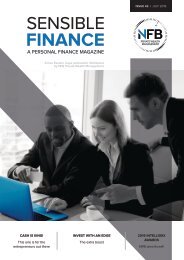NVFH 2020 Integrated Annual Report
Create successful ePaper yourself
Turn your PDF publications into a flip-book with our unique Google optimized e-Paper software.
NVest Financial Holdings Limited and its subsidiaries | (Registration number 2008/015990/06)
Annual Financial Statements for the year ended 29 February 2020
Accounting Policies [continued]
1.4 Significant judgements and sources of estimation uncertainty [continued]
Critical judgements in applying accounting policies
The critical judgements made by management in applying
accounting policies, apart from those involving estimations,
that have the most significant effect on the amounts
recognised in the financial statements, are outlined as
follows:
Lease classification
The group is party to leasing arrangements, both as a lessee
and as a lessor. The treatment of leasing transactions (where
the Group acts as a lessor) in the annual financial statements
is mainly determined by whether the lease is considered
to be an operating lease or a finance lease. In making this
assessment, management considers the substance of the
lease, as well as the legal form, and makes a judgement about
whether substantially all of the risks and rewards of ownership
are transferred. Based on the assessment performed by
management, it was determined that the substance of the
leasing arrangements were operating in nature.
The finance lease criteria were not satisfied per
management’s assessment as risks and rewards of ownership
were not deemed to have been transferred.
Expected manner of realisation for deferred tax
Management have reviewed the investment property
portfolio of the group in order to determine the appropriate
rate at which to measure deferred tax. Investment property
is measured at fair value. The manner of recovery of the
carrying amount, i.e. through use or sale, affects the
determination of the deferred tax assets or liabilities. IFRS
assumes that the carrying amount of investment property is
recovered through sale rather than through continued use.
Management considered the business model of the portfolio
and concluded that the assumption is not rebutted and that
the deferred taxation should be measured on the sale basis.
Key sources of estimation uncertainty
Impairment of financial assets
The impairment provisions for financial assets are based on
assumptions about risk of default and expected loss rates.
The group uses judgement in making these assumptions and
selecting the inputs to the impairment calculation, based on
the group’s past history, existing market conditions as well
as forward looking estimates at the end of each reporting
period. For details of the key assumptions and inputs used,
refer to the individual notes addressing financial assets.
Fair value estimation
Land and buildings and investment property, are revalued
on an annual basis, to fair value using observable market
data as inputs to the extent that it is available. It is the policy
of the group to obtain a independent valuation of all the
investment property within a three year rolling period. More
than one independent valuer may be used to provide the
valuation.
Impairment testing
The group reviews and tests the carrying value of assets when
events or changes in circumstances suggest that the carrying
amount may not be recoverable. When such indicators
exist, management determines the recoverable amount by
performing value in use and fair value calculations. These
calculations require the use of estimates and assumptions.
When it is not possible to determine the recoverable
amount for an individual asset, management assesses the
recoverable amount for the cash generating unit to which
the asset belongs.
Irrespective of whether there is any indication of impairment,
the group also tests intangible assets with an indefinite
useful life for impairment annually by comparing its carrying
amount with its recoverable amount. This impairment test is
performed during the annual period and at the same time
every period. The group tests goodwill acquired in a business
combination for impairment annually.
Useful lives of property, plant and equipment
Management assess the appropriateness of the useful lives
and residual values of property, plant and equipment at
the end of each reporting period. The useful lives of motor
vehicles, furniture and computer equipment are determined
based on group replacement policies for the various assets.
Individual assets within these classes, which have a significant
carrying amount are assessed separately to consider
whether replacement will be necessary outside of normal
replacement parameters.
When the estimated useful life of an asset differs from
previous estimates, the change is applied prospectively in
the determination of the depreciation charge.
1.5 Investment property
Investment property is recognised as an asset when, and
only when, it is probable that the future economic benefits
that are associated with the investment property will flow to
the enterprise, and the cost of the investment property can
be measured reliably.
Investment property is initially recognised at cost. Transaction
costs are included in the initial measurement.
Fair value
Subsequent to initial measurement investment property is
measured at fair value.
A gain or loss arising from a change in fair value is included in
net profit or loss for the period in which it arises.
NVest Financial Holdings Limited | INTEGRATED ANNUAL REPORT 2020 85






